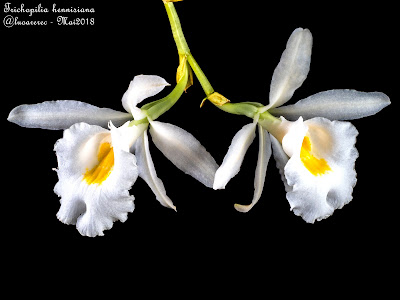Trichopilia orchid flowers are fragrant and have similar, narrow, pale green, pink to white sepals and petals that are sometimes strongly twisted...
Trichopilia orchid, also called as Helcia, Leucohyle, Neoescobaria, Pilumna, is a genus of the Orchidaceae family. This genus was described by John Lindley in 1836.
DESCRIPTION OF TRICHOPILIA ORCHID
Trichopilia orchid is native to Mexico to Tropical America. It is found growing in seasonally wet in montane cloud forests in Belize, Bolivia, Brazil North, Brazil Northeast, Brazil Southeast, Brazil West-Central, Colombia, Costa Rica, Cuba, Dominican Republic, Ecuador, El Salvador, French Guiana, Guatemala, Guyana, Haiti, Honduras, Jamaica, Mexico Gulf, Mexico Southeast, Mexico Southwest, Nicaragua, Panamá, Peru, Suriname, Trinidad-Tobago, Venezuela at elevations of 100-2500 meters above sea level.
It is a small to medium sized, sympodial epiphytic, occasionally lithophytic or terrestrial with small, clustered, laterally flattened, ovate pseudobulbs that are often subtended by brown-spotted, papery bracts. The single leaf is leathery peti olate.
The species in this genus blooms in late winter to early spring from the short, drooping, hanging to arching, few-flowered basal inflorescence. The flowers are fragrant and have similar, narrow, pale green, pink to white sepals and petals that are sometimes strongly twisted, with, or without, wavy margins. The lip is pale green to white, tubular and obscurely trilobed or bilobed; the short claw of the lip side lobes is fused to the base of the column, surrounding the slender, straight or club-shaped column, forming a funnel-shaped throat. Pollinia (two) are pear-shaped and waxy; the caudicles are irregularly shaped and the viscidium is oval.
TRICHOPILIA ORCHID CARE
Cultural information should only be used as a guide, and should be to be adapted to suit you. Your physical location; where you grow your plants, how much time you have to devote to their care, and many other factors, will need to be taken into account. Only then can you decide on the cultural methods that best suit you and your plants.
Light:
Trichopilia orchid needs a light level of 12000-25000 lux. The light should be filtered or dispersed, and the plants should never be exposed to direct sunlight. Strong air movement should be ensured all the time, especially in the case of the plants grown in lighter conditions, because their quite thick leaves are susceptible to burns.
Temperature:
The average temperature of the day in summer is 23-25 °C, night 13-15 °C, and the amplitude of daily fluctuations is 9-11 °C. The average winter temperature is 22-25 °C during the day and 11-13 °C at night, giving a daily difference of 11-14 °C.
Humidity:
The plants needs the humidity of 80-90% for most of the year, with a fall to 65-70% in late winter. Too dry air has a negative effect on the development of the plant: its growth is inhibited, and the leaves begin to turn yellow and dry out. The higher temperature, the higher the humidity should be, and the higher the humidity, the more often and longer it is necessary to ventilate the room where the plants are contained, otherwise the probability of rotting and various kinds of fungal diseases. Good air movement is essential while the plants are in leaf and growing. You can use a shallow tray of pebbles filled with water to increase humidity around your plants. Be sure the pot does not sit in water as this will rot the roots. Misting can also help in increasing humidity for limited period, but it causes leaf spot diseases if there is not good air circulation.
Substrate, growing media:
Trichopilia orchid grows well attached to pieces of tree ferns or cork, with high humidity ensured and daily watering during the summer. During the dry and hot periods it may be necessary to water several times a day.
They can also grow in pots with a loose substrate, quickly draining excess water, which, however, contains substances that retain a certain amount, such as cut sphagnum moss or perlite. Wood charcoal is also often added to ensure the air permeability of the substrate and protection against acidification.
Repotting:
The plants should be replanted before the substrate begins to be less permeable. The most appropriate time of the year for repotting is the end of winter preceding flowering, as flowers and new growths appear almost at the same time. Therefore, the plants should be repotted when new roots start growing or only a little earlier. This allows the plants to acclimatize in a relatively short time and provides them with the least stress. This is very important, because the plants must acclimate to the additional stress caused by the approaching hot, dry, summer weather.
Watering:
The plants should be watered frequently during active growth, but there should be excellent drainage and the roots need to dry a bit between waterings. The substrate around the roots must never be stale or soggy. When new growths reach maturity in late autumn, the amount of water should be gradually reduced.
Fertilizer:
During the active growth, the plant should be fertilized every week 1/4-1/2 of the recommended dose of fertilizer for orchids. At the beginning of the year, when new growths appear and intensively develop, you can use a fertilizer with an increased nitrogen content, then in late summer and autumn the plants should be fed a fertilizer with an increased content of phosphorus in order to initiate flowering and facilitate the maturation of young growth.
Rest period:
Trichopilia orchid do not need a rest period but can grow and bloom better if they are given a cool and dry dormant period for several weeks. In winter, for 1-2 months, the plants need less water when not actively grown, especially when grown in low light during the short mid-latitude days. They should dry somewhat between waterings, but should not be dry for a longer period. The plant should be supplied with the amount of water that will prevent the pseudobulbs from wrinkling. Fertilization should be limited or should be completely abandoned until new growths appear.















COMMENTS